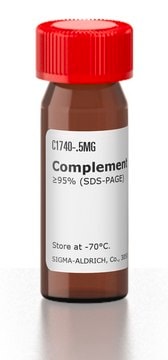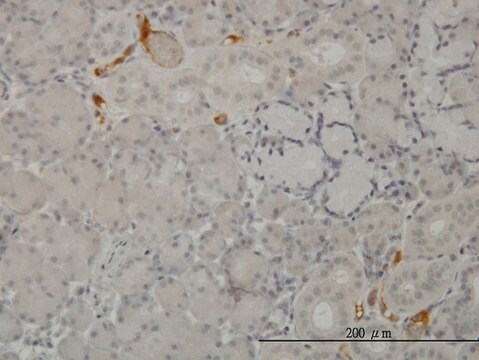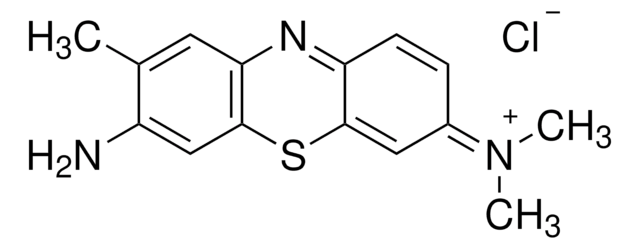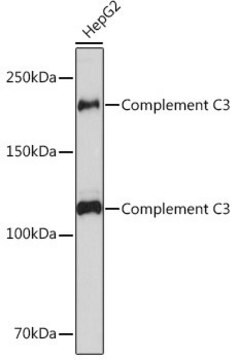GW20073F
Anti-Complement C3 antibody produced in chicken
affinity isolated antibody, buffered aqueous solution
Synonym(s):
Anti-AHUS5, Anti-ARMD9, Anti-ASP, Anti-C3a, Anti-C3b, Anti-CPAMD1, Anti-HEL-S-62p
Sign Into View Organizational & Contract Pricing
All Photos(1)
About This Item
Recommended Products
biological source
chicken
Quality Level
conjugate
unconjugated
antibody form
affinity isolated antibody
antibody product type
primary antibodies
clone
polyclonal
form
buffered aqueous solution
species reactivity
human
manufacturer/tradename
Genway 15-288-20073F
technique(s)
indirect ELISA: suitable
western blot: suitable
NCBI accession no.
UniProt accession no.
shipped in
wet ice
storage temp.
−20°C
target post-translational modification
unmodified
Gene Information
human ... C3(718)
General description
Chicken polyclonal anti-Complement C3 antibody reacts with human complement C3.
Complement C3 plays a central role in the activation of the complement system. It′s processing by C3 convertase is the central reaction in both classical and alternative complement pathways. After activation C3b can bind covalently, via its reactive thioester, to cell surface carbohydrates or immune aggregates. Derived from proteolytic degradation of complement C3, C3a anaphylatoxin is a mediator of local inflammatory process. It induces the contraction of smooth muscle, increases vascular permeability, and causes histamine release from mast cells and basophilic leukocytes.
The complement factor 3 (C3) gene, with 41 exons spanning 41kb on genomic DNA, is mapped to human chromosome 19p13.3. It is the third component of complement and is characterized with α and β chains. It is one of the most abundant complement protein in the serum.
Application
Anti-complement C3 antibody produced in chicken has been used in immunoblot analysis.
Applications in which this antibody has been used successfully, and the associated peer-reviewed papers, are given below.
Western Blotting (1 paper)
Western Blotting (1 paper)
Chicken polyclonal anti-Complement C3 antibody is used to tag complement C3 for detection and quantitation by immunocytochemical and immunohistochemical (IHC) techniques such as ELISA and western blotting. It is used as a probe to determine the presence and roles of complement C3 as a component of the complement system.
Biochem/physiol Actions
Complement factor 3 (C3) plays an essential role in the activation of the complement system. C3-convertase (C4b2a) cleaves C3 complement into C3a and C3b. C3b can bind covalently, through its reactive thioester, to cell surface carbohydrates or immune complexes and involve in the self-activation loop of complement activation via the alternate pathway. In addition, C3b also interacts with C3 convertases (C4b2a or C3bBb) to form the C5 convertase, which cleaves complement factor 5 into C5a and C5b. Derived from proteolytic degradation of complement C3, C3a (anaphylatoxin) facilitates the recruitment of inflammatory cells. C3a stimulates smooth muscle contraction, enhances vascular permeability and causes histamine release from mast cells and basophilic leukocytes. Mutation in C3 gene leads to the development of age-related macular degeneration (AMD).
Physical form
Solution in phosphate buffered saline containing 0.02% sodium azide.
Disclaimer
Unless otherwise stated in our catalog or other company documentation accompanying the product(s), our products are intended for research use only and are not to be used for any other purpose, which includes but is not limited to, unauthorized commercial uses, in vitro diagnostic uses, ex vivo or in vivo therapeutic uses or any type of consumption or application to humans or animals.
Not finding the right product?
Try our Product Selector Tool.
Storage Class Code
12 - Non Combustible Liquids
WGK
WGK 1
Flash Point(F)
Not applicable
Flash Point(C)
Not applicable
Personal Protective Equipment
dust mask type N95 (US), Eyeshields, Gloves
Choose from one of the most recent versions:
Already Own This Product?
Find documentation for the products that you have recently purchased in the Document Library.
Kamran Ullah et al.
Journal of molecular endocrinology, 59(2), 105-119 (2017-05-26)
Previous studies have shown that increasing estradiol concentrations had a toxic effect on the embryo and were deleterious to embryo adhesion. In this study, we evaluated the physiological impact of estradiol concentrations on endometrial cells to reveal that serum estradiol
Giuseppina Arbore et al.
Nature communications, 9(1), 4186-4186 (2018-10-12)
The induction of human CD4+ Th1 cells requires autocrine stimulation of the complement receptor CD46 in direct crosstalk with a CD4+ T cell-intrinsic NLRP3 inflammasome. However, it is unclear whether human cytotoxic CD8+ T cell (CTL) responses also rely on
Michelle Elvington et al.
The Journal of clinical investigation, 127(3), 970-981 (2017-02-14)
An intracellular complement system (ICS) has recently been described in immune and nonimmune human cells. This system can be activated in a convertase-independent manner from intracellular stores of the complement component C3. The source of these stores has not been
Atsuhiko Toyama et al.
Proteome science, 9, 18-18 (2011-04-09)
Serum is an ideal source of biomarker discovery and proteomic profiling studies are continuously pursued on serum samples. However, serum is featured by high level of protein glycosylations that often cause ionization suppression and confound accurate quantification analysis by mass
Vince C De Hoog et al.
Cardiovascular research, 103(4), 521-529 (2014-06-18)
Early reperfusion is mandatory for the treatment of acute myocardial infarction. This process, however, also induces additional loss of viable myocardium, called ischaemia-reperfusion (IR) injury. Complement activation plays an important role in IR injury, partly through binding of C5a to
Our team of scientists has experience in all areas of research including Life Science, Material Science, Chemical Synthesis, Chromatography, Analytical and many others.
Contact Technical Service








